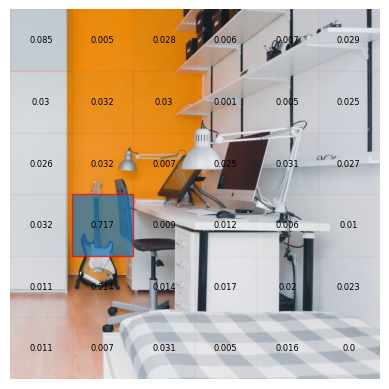Explainability
In the previous section, we explained how you can steer the attention of our models and either suppress or amplify parts of the input sequences. Very roughly speaking, our explainability method uses AtMan to suppress individual parts of a prompt to find out how they would change the probabilities of the generated completion relative to each other. In the following example, we will investigate which part of the prompt influenced the completion the most.
I
0.829
am
-0.246
French
1.214
.
0.445
My
0.193
favourite
0.766
food
0.790
is
-0.010
cheese
Below, find the changes in the log-probs of the distribution if we suppress the respective word. We see that the word "French" contributed to the completion "cheese" the most. Let's see how this changes if we adjust the prompt:
I
0.055
am
-0.048
French
-1.025
and
-0.275
a
-0.0811
programmer
0.349
.
-0.141
My
0.125
favourite
0.779
food
0.278
is
0.079
pizza
This new completion and the respective scores are interesting for a couple of reasons. We get a different completion even though we only changed the prompt marginally. The words "programmer", "favourite" and "food" contributed positively to the completion and their combination of these words led to the final completion "pizza". Still, the explanations show that "French" has the greatest influence on the completion, just in a negative direction this time. This means that the word "French" made the completion "pizza" less likely.
Explainability on Images
We also offer our explainability method for multimodal input. If you provide text and an image as input, you can see how the text and the image contributed to the completion.

The
0.077
instrument
1.0
on
0.112
the
0.051
picture
0.117
is
0.001
a
0.001
guitar.
The word "instrument" as well as the tile with the head of the guitar contributed most to the completion.
Hallucination Detection
Large Language Models tend to hallucinate at times. That means that they can produce completions that seem plausible, but contain made-up, irrelevant, or incorrect information. Consider the following example, where we ask a question that the model answers based on world knowledge and not the context.
Answer the question based on the context.
0.216
Context: According to tradition, on April 21, 753 BC, Romulus and his twin brother Remus founded Rome in the place where they had been suckled as orphans by a she-wolf.
-0.181
Q: In which country is Rome located?
3.710
A:
0.110
Italy
We see that the context did not contribute to the explanation at all, indicating that the answer is hallucinated. If we ask a question where the answer is in the text, the contribution of the prompt is way higher, giving us a good indication of the quality of the reply.
Answer the question based on the context.
0.276
Context: According to tradition, on April 21, 753 BC, Romulus and his twin brother Remus found Rome in the place where they had been suckled as orphans by a she-wolf.
0.85
Q: In which month was Rome founded?
2.205
A:
0.776
April
Now, the context had a significant positive influence on the completion. Therefore, we can assume that the answer is not hallucinated and stems from the context that we provided in the prompt.